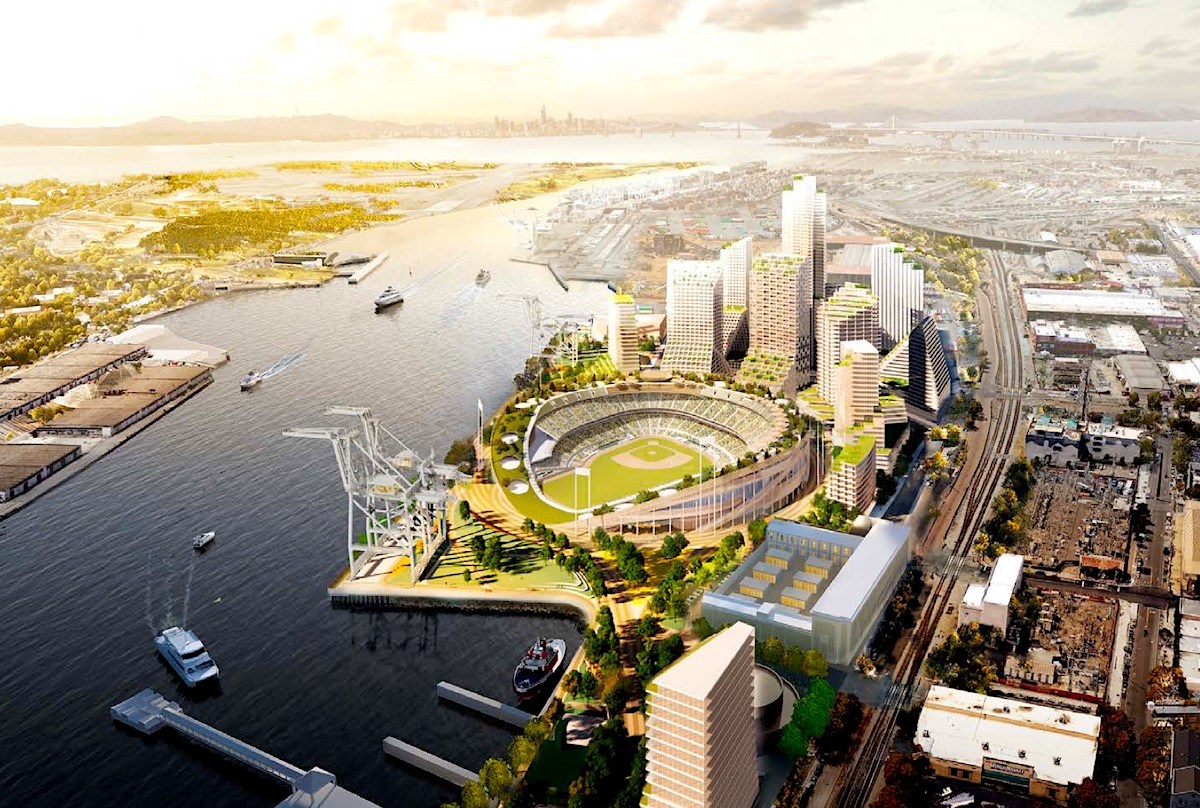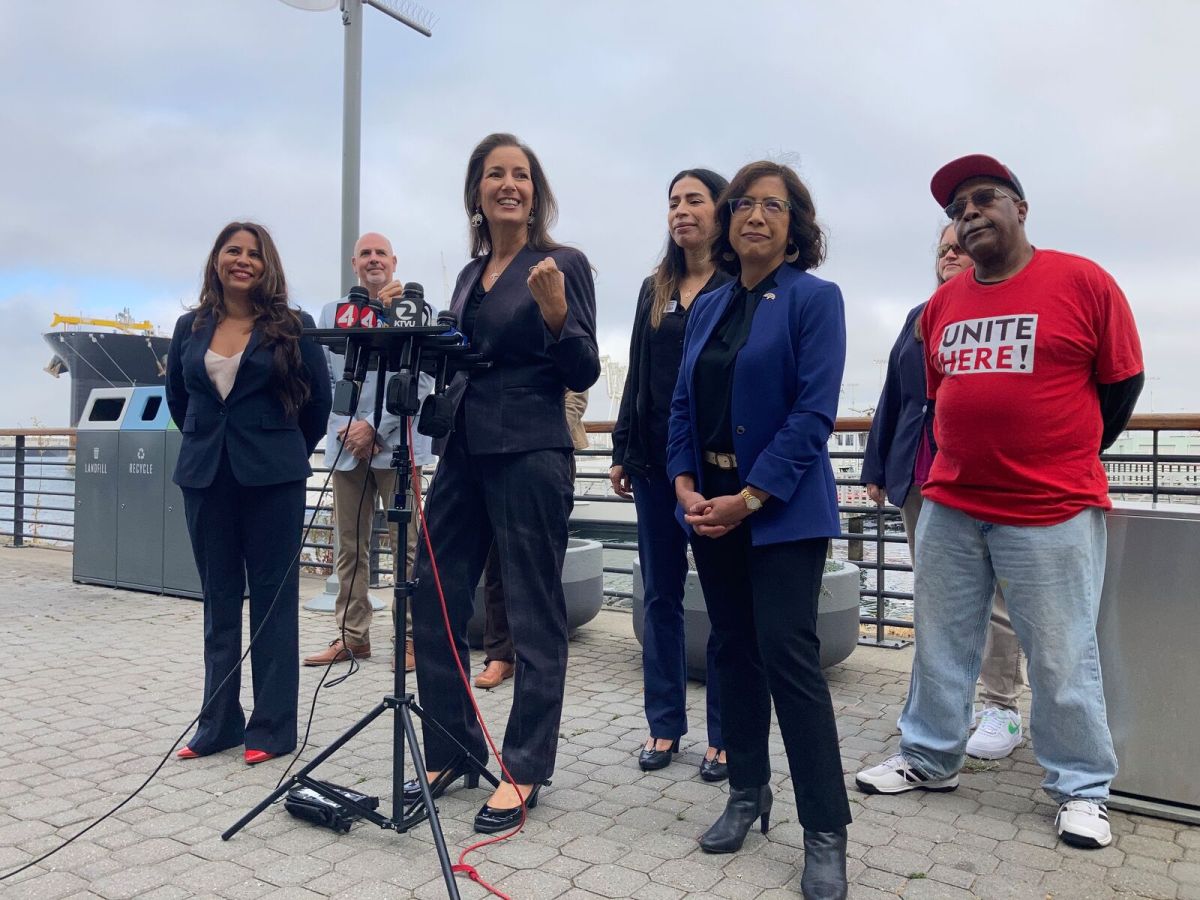The Oakland City Council made it clear during a meeting Tuesday that they support continuing negotiations with the A’s to keep the Major League Baseball team in Oakland by allowing the club to build a new 35,000-person capacity ballpark at Howard Terminal along with 3,000 units of housing, 18.5 acres of parks, 1.5 million square feet of commercial office space, and 270,000 square feet of retail shops.
But the councilmembers said they won’t allow the city to enter into a deal that puts tax dollars from the general fund on the hook for infrastructure upgrades around the A’s megaproject.
The councilmembers also appeared united in demanding that the A’s commit to a strong community benefits package that would require at least 15% of new housing built by the A’s at Howard Terminal be priced affordable, and that the team take other steps to prevent harm to low-income neighborhoods like West Oakland and Chinatown.
Any final agreement will also need to ensure that longshore, trucking, and other jobs at the Port of Oakland won’t be lost as a result of the project, per the City Council’s terms.
“This has to be a good deal for our taxpayers,” said City Council President Nikki Fortunato Bas during the meeting. “Second, this has to be a deal that allows our port to continue to thrive and grow. Third, this deal has to really benefit the most impacted communities, the West Oakland community certainly, and also the Chinatown community that I represent.”
Immediately after the vote, Mayor Libby Schaaf and Bas issued a joint statement: “This is the path to keeping the A’s Rooted in Oakland in a way that protects our Port and tax payers and will produce the benefits our community demands and deserves.”
A’s President Dave Kaval briefly spoke during the council meeting, saying his organization doesn’t like the terms offered by the city.
“The current term sheet with these amendments is not something that the A’s have consensus around,” said Kaval before the vote. “Voting yes on something that we don’t agree with, that we don’t have consensus around, is not an effective path forward.”
The terms the council approved are non-binding and meant only to guide further negotiations between the A’s and city toward an eventual development agreement—a contractual deal that would be enforceable.
It’s not immediately clear what will result from yesterday’s vote. One possible outcome is that the A’s could discontinue negotiations with the city, after signaling for months that they want Oakland to approve major tax subsidies to pay for their project, something the city has so far refused to do. Over the past couple months, the team’s leaders have taken trips to Las Vegas and Portland to explore relocating.
A vote the A’s demanded, but not the terms they wanted

Yesterday’s City Council vote was highly unusual. Normally, the city and developers like the A’s hash out deals in private, only voting on terms after most of the details have been agreed on. But in April, the A’s and Major League Baseball released a “term sheet” to the public outlining what the team wants from the city for a new ballpark at Howard Terminal. The A’s then asked the City Council to vote on the document before the end of July.
Under the A’s proposal, the team would spend $1 billion on a ballpark, and the city would create a special infrastructure financing district around the park to help pay for other project costs like environmental cleanup, utilities, parks, and more. The city has agreed to this idea.
But the A’s also want the city to create a second, larger infrastructure financing district surrounding the entire Jack London District and portions of West Oakland, which would include numerous properties not owned by the team. Future increases in tax revenue from these properties would be used to pay for off-site infrastructure surrounding the stadium and the massive $11 billion housing and commercial development the A’s plan to build around it. This includes things like sidewalks, bike lanes, railroad safety improvements, and more, and is estimated to cost upwards of $360 million.
The A’s also want to use infrastructure financing district revenue to pay for the community benefits that a broad coalition of Oakland community organizations and elected officials are demanding. Possible benefits include affordable housing, but the A’s haven’t committed to include affordable housing within the 3,000 units they’ve proposed building around the ballpark. City officials have said over the past few days that they believe the A’s are starting to budge on this point, however.
The term sheet approved yesterday by the council was introduced by city of Oakland staff last Friday. Rather than earmark public tax revenue for the A’s project by creating a second infrastructure financing district, the city’s plan, per amendments made during the council meeting by Councilmember Rebecca Kaplan, would seek to obtain federal, state, and regional transportation authority funds. This would also amount to public financing, but remove the burden from Oakland taxpayers. Mayor Schaaf, Kaplan, and Bas all believe that the massive federal infrastructure bill currently moving through Congress could be one major source of funds for the project.
The city and A’s also differ on where the money for affordable housing and a community fund used to pay for other things, including possibly tenant services to prevent displacement of low-income West Oakland and Chinatown residents, will come from. The A’s want to use infrastructure district revenue—public funds—to pay for these benefits, while the city wants the A’s to pay for more of these things.
The councilmember’s plan would require the A’s to commit to making at least 15%, or 450 of the 3,000 housing built at Howard Terminal, affordable. The A’s would also need to set up a fund that would collect millions of dollars, some of which could be used to build about 500 more units of affordable housing offsite.
Housing advocate James Vann of the Oakland Tenants Union criticized the affordable housing requirements in the city’s term sheet at yesterday’s meeting, noting that it’s still unclear just how affordable the units would be. Some affordable housing is priced so that people who earn 80% to 120% of an area’s median average income can afford to rent it. “Any affordable housing will require someone to have an income of $90,000 to be eligible,” said Vann.
A once-in-a-generation opportunity to transform the city

The ballpark project has created deep divisions in Oakland, which were evident during public comment at the City Council meeting.
Some labor unions pleaded with the council to approve the project, while a few others objected to the Howard Terminal site.
Delinda Horton, an Oakland native who has worked for 24 years at the Coliseum, where the A’s currently play, told the council that losing the team would be devastating for hundreds of the city’s residents who rely on the club to make a living.
Barbara Edwards, another Coliseum employee, echoed Horton, but added that the need for affordable housing is great too. “We need to stay in Oakland. We need our jobs. Everyone needs to have affordable housing. I hope you guys can work with the A’s somehow to resolve this,” she said.
Port workers have been critical of the Howard Terminal plans because they fear a stadium on the waterfront will interfere with the port over the long-run, costing jobs. “This is a billionaire looting the city,” said Aaron Wright, a business agent for the ILWU Local 10, which represents longshore workers.
Another port worker, Evey Hwang, described how the Howard Terminal proposal has polarized Oakland: “This whole thing is pitting East against West Oakland residents, port businesses against residential, and building unions against longshore unions.”
City leaders have negotiated with the A’s for over a year now because of the billions of dollars at stake and the possibility that the ballpark and development could be a positive force, creating hundreds of units of affordable housing, good paying jobs, and much more.
But most of the councilmembers expressed frustration with the A’s at yesterday’s meeting.
“After the city has bent over backwards and provided some of their best work in the interests of Oakland residents, and come up with all of these concessions, including how these wealthy owners don’t have to pay for off site infrastructure, I don’t know where we go from here after doing somersaults, after receiving insults, after being disrespected, after all of the things Oakland A’s fans and Oakland residents have gone through,” said District 3 Councilmember Carroll Fife. “It’s really not a negotiation; it’s do what we say or we’ll leave.”
Fife abstained from voting on the term sheet.
District 5 Councilmember Noel Gallo said he still only supports construction of a new stadium at the current Coliseum location in East Oakland and voted no on the terms.
The rest of the council voted yes, hoping to keep the A’s at the bargaining table, but also had sharp words for A’s president Kaval.
District 1 Councilmember Kalb criticized the A’s for not going beyond the minimum of what’s required under the law to build affordable housing. Before the vote, Kalb said he would “hold his nose” and “throw up” because the deal still doesn’t do enough, in his view, to protect Oakland residents.
District 6 Councilmember Taylor called the A’s recent behavior “bullying,” adding, “If we were voting on the A’s and how they’ve behaved, that piece, it would certainly be a no vote,” just before voting yes on the term sheet.
Even if the A’s and city go back to the negotiating table and eventually hash out an agreement, the City Council will still have to vote on a final development agreement, which can’t happen before the fall, and the A’s will also have to gain approval of a final environmental impact report and approvals from the Port of Oakland, as well as land use approvals.
On Wednesday morning, Schaaf and Bas held a press conference in Jack London Square, with Howard Terminal in the background. Sometimes rivals, the duo have collaborated closely on the A’s deal. They said yesterday’s vote is a victory for Oakland and that they fully expect to keep the A’s at the bargaining table.
“What the City Council approved yesterday is not just one of the most iconic ballparks that the world will ever see, but an entire beautiful community-serving ballpark district, a new neighborhood with amazing union jobs, public parks, affordable housing,” said Schaaf.

